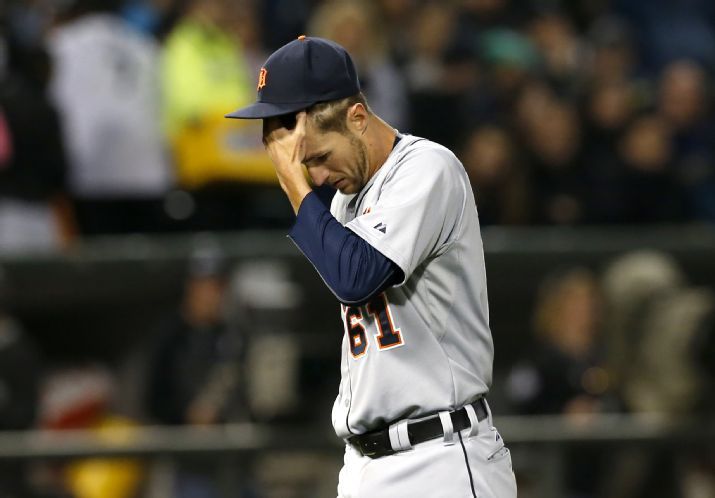Ain’t no change in the weather,
ain‘t no changes in me.
And I ain’t hiding from nobody,
nobody’s hiding from me.
Detroit Tigers fans weren’t sure what to expect out of their new starting pitcher when Shane Greene arrived from New York this past offseason. As I noted in this site’s Tigers season preview, the scouting report on Greene was, to be kind to his prospects, guarded: “an average pitcher — in Triple-A” with a major-league “path for . . . success [that is] very rarely traveled.” He had done moderately well in his fourteen-start rookie campaign, which included two wins– the first an eight-inning shutout– over the Tigers, and the primary question for him entering 2015 was whether he could replicate his success in limited outings across a full season’s worth of starts. After one month of baseball, the answer to that question, like most others at this point in the season, remains outstanding.
Greene has made six starts so far, and his performance has been a tale of two sets of three starts. The first three were effective, efficient, and smoother than a cumbersome adaptation of a Dickens reference. He used just eighty-five and eighty-one pitches, respectively, to complete eight innings in each of the first two starts, allowing one run, one walk, and seven hits between the two games. His third start was similar: 102 pitches, seven innings, one run, four walks, five hits. Three starts, three wins. Hope for Greene sprouted in Detroit’s chilly April.
The only resemblance Greene’s next three starts bore to his first three was that his pitch count remained under 100 for each one. Unfortunately, the reason for that similarity was the wrong sort of efficiency. He surrendered twenty runs on twenty-three hits in those three games. He barely made it to the fifth inning in two of them, and couldn’t get out of the third inning in the last one. Allowing four runs on a single, a triple, and three walks in one inning will do that to a guy.
After three virtually unblemished starts to begin the season, Greene’s DRA has climbed rapidly to 4.26, and the emerging vision of a bright young star has become significantly clouded. What happened?
Early analysis suggested that a possible source of Greene’s success was the addition of a new pitch to his repertoire. Writing for FanGraphs, Owen Watson explained that Greene’s “new-and-improved change up is a big deal. If more effective, it would hope to give him a real weapon against left-handed hitters and narrow that platoon [historically a weakness of Greene’s]. It would also go a long way toward making him a successful starter for the future.” Greene used a change up just 4.7% of the time in 2014. At the time of Watson’s writing, which was after Greene’s first two starts, however, he’d thrown it 12% of the time, and the pitch itself looked better than what he was offering last year. Watson also noted a full mile-per-hour drop in velocity from the 2014 version of the change up.
Greene’s use of his change remained steady through his first two starts, as Watson noted, dipped a bit in his third start, spiked in the fourth, and dropped back off in the fifth and sixth.

In the first three games, the change up was Greene’s most effective pitch. Since then, it has become his least effective.

While Greene continues to throw the change exclusively against lefties, its usage has flatlined, possibly to be replaced in the mix with the slider, a more familiar pitch for him.
It would not be surprising if Greene is abandoning his new pitch, as Watson allowed he might, because it has become ineffective. As outside observers, we can only speculate about the reason or reasons it isn’t working for him. (The pitch’s velocity, movement, and release point appear to have remained fairly steady within the context of his other pitches on a game-to-game basis thus far.) He simply may have lost confidence in his mechanics for the new pitch. Perhaps increased batter familiarity with his offerings in general, or the change in particular, is the problem, similar to the way NBA defenders eventually gained a handle on Jeremy Lin following his meteoric breakout.
The spread between his 4.26 DRA and his 5.56 ERA suggests that his recent collapse isn’t entirely his fault, but the correlation between Greene’s changeup effectiveness and his overall level of success is difficult to ignore. As much as Greene’s noted increased change up usage rate during his first two starts supported Watson’s hypothesis that Greene needed this new pitch in his arsenal to succeed in a starting rotation, the negative results of his last three outings– both generally and with the change up specifically– would appear to confirm it. Elementary, right?
It’s still early, of course, and every young starter is bound to encounter some bumps in the road. After three excellent performances and three poor ones, Greene’s next appearance, which should come on ESPN’s Sunday Night Baseball broadcast against a Kansas City lineup with plenty of lefty batters, could go a long way toward telling us what sort of pitcher Greene will be in his first season as a full-time starter.
More of AD’s work may be found at ALDLAND.
Next post: Write-Up For Yesterday (May 7, 2015)Previous post: Billy Burns: The A’s are Believing the Hype





Leave a Reply